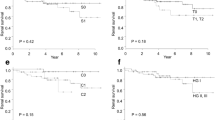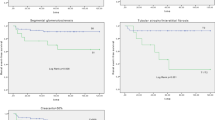Abstract
Henoch–Schönlein purpura nephritis (HSPN) is a common secondary glomerulonephritis, and its prognosis mainly depends on the severity of renal impairment. To date, the significance of crescent lesions in adult-onset HSPN is still unclear. Therefore, the purpose of this research was to assess whether crescents could predict the renal outcomes in adult HSPN patients. A total of 188 adult patients with HSPN proven by renal biopsy were enrolled in this prospective study. Patients were divided into three groups based on the proportion of crescents: non-crescent group (C0, n = 110), crescent ≤ 25% group (C1, n = 50) and crescent > 25% group (C2, n = 28). The composited endpoint was defined as eGFR decreased > 50% of baseline level, reached end-stage renal disease and/or death. Among three groups, clinical pathological features, treatment regimens and renal outcomes were compared. During a mean follow-up of 26 months, 78 (42.5%) patients had crescent lesions. A total of ten (9.1%) patients in C0 group and five (17.9%) patients in C2 group reached the combined endpoint, but no patients in C1 group reached endpoint. Renal survival analysis indicated patients in C1 group tended to have the best renal outcome, while patients in C2 group had the poorest renal survival. Moreover, Cox regression analysis revealed crescents were not a predictor of poor developing to renal outcome after adjusting potential confounders [hazard ratio (HR) = 0.28, 95% confidence interval (CI) 0.07–1.18, P = 0.083]. Crescent formation is not necessarily a predictive factor of poor renal survival in adult HSPN patients who had small proportions of crescents (crescent ≤ 25%).


Similar content being viewed by others
References
McCarthy HJ, Tizard EJ. Clinical practice: diagnosis and management of Henoch–Schonlein purpura. Eur J Pediatr. 2010;169(6):643–50.
Delbet JD, Hogan J, Aoun B, et al. Clinical outcomes in children with Henoch–Schonlein purpura nephritis without crescents. Pediatr Nephrol (Berlin, Germany). 2017;32(7):1193–9.
Davin JC. Henoch–Schonlein purpura nephritis: pathophysiology, treatment, and future strategy. Clin J Am Soc Nephrol CJASN. 2011;6(3):679–89.
Ronkainen J, Ala-Houhala M, Huttunen NP, et al. Outcome of Henoch–Schoenlein nephritis with nephrotic-range proteinuria. Clin Nephrol. 2003;60(2):80–4.
Ronkainen J, Nuutinen M, Koskimies O. The adult kidney 24 years after childhood Henoch–Schonlein purpura: a retrospective cohort study. Lancet (London, England). 2002;360(9334):666–70.
Shrestha S, Sumingan N, Tan J, Alhous H, et al. Henoch Schonlein purpura with nephritis in adults: adverse prognostic indicators in a UK population. QJM Mon J Assoc Physicians. 2006;99(4):253–65.
Wang J, Zhu P, Cui Z, et al. Clinical features and outcomes in patients with membranous nephropathy and crescent formation. Medicine. 2015;94(50):2294.
Roberts IS, Cook HT, Troyanov S, et al. The Oxford classification of IgA nephropathy: pathology definitions, correlations, and reproducibility. Kidney Int. 2009;76(5):546–56.
Kim CH, Lim BJ, Bae YS, et al. Using the Oxford classification of IgA nephropathy to predict long-term outcomes of Henoch–Schonlein purpura nephritis in adults. Mod Pathol. 2014;27(7):972–82.
Levey AS, Stevens LA, Schmid CH, Zhang YL, Castro AF 3rd, Feldman HI, et al. A new equation to estimate glomerular filtration rate. Ann Intern Med. 2009;150(9):604–12.
Zhang W, Zhou Q, Hong L, et al. Clinical outcomes of IgA nephropathy patients with different proportions of crescents. Medicine. 2017;96(11):e6190.
Kusano T, Takano H, Kang D, et al. Endothelial cell injury in acute and chronic glomerular lesions in patients with IgA nephropathy. Hum Pathol. 2016;49:135–44.
Shao X, Li B, Cao L, et al. Evaluation of crescent formation as a predictive marker in immunoglobulin A nephropathy: a systematic review and meta-analysis. Oncotarget. 2017;8(28):46436–48.
Rafieian-Kopaei M, Baradaran A, Nasri H. Significance of extracapillary proliferation in IgA-nephropathy patients with regard to clinical and histopathological variables. Hippokratia. 2013;17(3):258–61.
Bitencourt-Dias C, Bahiense-Oliveira M, Saldanha LB, et al. Comparative study of IgA nephropathy with and without crescents. Brazilian J Med Biol Res. 2004;37(9):1373–7.
Huang X, Wu X, Le W, et al. Renal prognosis and related risk factors for Henoch–Schonlein purpura nephritis: a Chinese adult patient cohort. Sci Rep. 2018;8(1):5585.
Tumlin JA, Lohavichan V, Hennigar R. Crescentic, proliferative IgA nephropathy: clinical and histological response to methylprednisolone and intravenous cyclophosphamide. Nephrol Dial Transpl. 2003;18(7):1321–9.
Schena FP, Manno C. Intensive supportive care plus immunosuppression in IgA nephropathy. New Engl J Med. 2016;374(10):992.
Shen XH, Liang SS, Chen HM, et al. Reversal of active glomerular lesions after immunosuppressive therapy in patients with IgA nephropathy: a repeat-biopsy based observation. J Nephrol. 2015;28(4):441–9.
Miller MN, Baumal R, Poucell S, et al. Incidence and prognostic importance of glomerular crescents in renal diseases of childhood. Am J Nephrol. 1984;4(4):244–7.
Lee MJ, Kim SJ, Oh HJ, et al. Clinical implication of crescentic lesions in immunoglobulin A nephropathy. Nephrol Dial Transpl. 2014;29(2):356–64.
Haas M, Verhave JC, Liu ZH, et al. A multicenter study of the predictive value of crescents in IgA nephropathy. J Am Soc Nephrol JASN. 2017;28(2):691–701.
Zhang X, Shi S, Ouyang Y, et al. A validation study of crescents in predicting ESRD in patients with IgA nephropathy. J Transl Med. 2018;16(1):115.
Rianthavorn P, Chacranon M. Long-term renal outcome in pediatric glomerulonephritis associated with crescent formation. Clin Exp Nephrol. 2018;22(3):661–7.
Author information
Authors and Affiliations
Corresponding author
Ethics declarations
Conflict of interest
The authors declare that they have no conflict of interest.
Ethical approval
All procedures performed in studies involving human participants were in accordance with the ethical standards of the Ethics Committee of West China Hospital of Sichuan University and with the 1964 Declaration of Helsinki and its later amendments or comparable ethical standards.
Informed consent
Additional informed consent was obtained from all individual participants for whom identifying information is included in this article.
Additional information
Publisher's Note
Springer Nature remains neutral with regard to jurisdictional claims in published maps and institutional affiliations.
Rights and permissions
About this article
Cite this article
Zhong, ZX., Tan, JX., Tang, Y. et al. Crescent lesions are not a predictive factor in adult-onset Henoch–Schönlein purpura nephritis. Clin Exp Med 19, 449–456 (2019). https://doi.org/10.1007/s10238-019-00567-6
Received:
Accepted:
Published:
Issue Date:
DOI: https://doi.org/10.1007/s10238-019-00567-6




